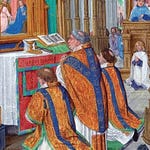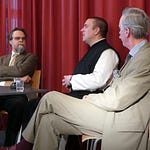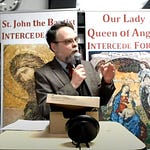Critics of the Traditional Latin Mass often raise the objection that the priest is “far away” from the congregation, set apart as the only one offering the liturgy; that he “does everything” and they “do nothing”; that he ignores them, and they are lost; etc. These are the sorts of claims that drove the original liturgical reforms of the 1960s. Experience and study show that such objections are rather superficial and that, if we think about things more carefully, the traditional approach makes much more sense of the paradoxes of divine worship. The hieratic distance between priest and people serves to accentuate the divine presence that invites all of us deeper into the liturgy and impresses on us the seriousness of our common work of worship. The priest’s more involved role serves as a model and an invitation for the faithful’s prayer, as they learn from watching and following, like apprentices from a master. The apparent “ignoring” of us people in the pews by ministers busy in the sanctuary liberates us from a merely horizontal and human “self-enclosed circle” in which the higher acts of prayer are suffocated in low-level communication and comprehension. This lecture is a no-holds-barred defense of the "sacerdotalism" or priest-centeredness of the old rite and of its immeasurable superiority for the spiritual life of the priest as well as for the spiritual life of his people. (Given at St. Edward on the Lake Catholic Church, Lakeport, Michigan, March 4, 2022. Includes Q&A.)
The Relationship between Priest and People in the Latin Mass: Space and Time for Divine Intimacy
Feb 20, 2023
Tradition and Sanity
The best in Catholic culture, the Latin Mass, Sacred Music, theology, and more, brought to you from Tradition and Sanity Substack by Peter and Julian Kwasniewski. Visit traditionsanity.substack.com!
The best in Catholic culture, the Latin Mass, Sacred Music, theology, and more, brought to you from Tradition and Sanity Substack by Peter and Julian Kwasniewski. Visit traditionsanity.substack.com!Listen on
Substack App
Spotify
YouTube
Pocket Casts
RSS Feed
Recent Episodes












